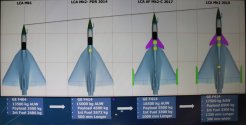For India especially, the phrase "a bird in the hand is worth two in the bush" very much applies. Mk. 1A essentially tries to make the best of the "proven" Mk. 1 airframe, while Mk. 2 accepts more risk to deliver more capability. As the scope of planned Mk. 2 improvements increased (see attached image), alongside associated risk profile, space opened up for Mk. 1A. Given the many schedule slippages of Mk. 2 to date, it is almost certainly sensible to focus on what can actually be delivered, in the form of Mk. 1A. In hindsight, one opportunity that was missed in recent years was to opt for a significantly larger Mk. 1A buy in the first place, rather than this piecemeal structure. A larger block buy would've improved economies of scale and commercial incentives throughout the supply chain. Of course one major reason that did not happen is because IAF has (somewhat justifiably) been skeptical of the entire enterprise and has been reluctant to commit.
Yep, it was originally meant as a big upgrade like J-10C to J-10A.
Now it's simply a different aircraft, taking parallel role. 50% mtow increase, different aerodynamic configuration, 100% more payload while having substantially more equipment inside.
Mk.1a is more or less traditional Soviet style fighter-interceptor, rather barbone (though meant to have quite a few optional payloads...for the few suspension points it has).
Plus it's rumored it can't take its declared MTOW load.
MAWS? pod. Jammer? pod. IRST? pod...
All that on a small light aircraft, which won't really cross edge of the airbase without tanks, and where every bit of additional drag hits a lot.
Mk.2 on the other hand is meant to deliver a full on (light) multirole fighter, with very visible focus on delivering just that - payloads.
And indeed, having gentleman suit inside (maws, irst) it's just much easier to configure for actual strike mission.
On the other hand - if we talk about more simple GCI missions, mk.1A already does what mk.2 will only do later, for a lot of development money and future development risks.


